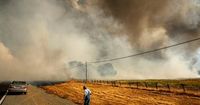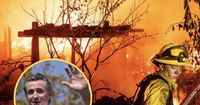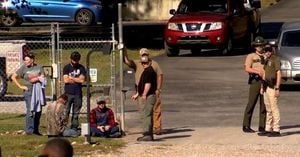Wildfires have once again left a trail of devastation across the American West, with two historic sites—the North Rim of the Grand Canyon in Arizona and the Gold Rush-era town of Chinese Camp in California—bearing the brunt of nature’s fury in the first days of September 2025. As officials tally the losses and residents grapple with uncertainty, the fires have reignited debates about preparedness, leadership, and the preservation of irreplaceable heritage.
The Dragon Bravo Fire, a relentless blaze sparked by a lightning strike on July 4, 2025, tore through the North Rim of the Grand Canyon, one of the nation’s most beloved natural landmarks. According to the Department of Interior’s Burned Area Emergency Response Team, the fire’s toll is staggering: nearly half of the North Rim’s 229 structures were either damaged or destroyed by flames. Among the 106 structures lost are the iconic Grand Canyon Lodge, the visitor’s center, and a critical wastewater treatment plant. The devastation has left the area’s future uncertain, with cleanup crews now tasked with addressing hazardous materials at three high-risk sites, including the damaged treatment plant and areas adjacent to the lodge.
Firefighters faced a daunting challenge almost from the start. A week after the initial lightning strike, strong winds on July 11 sent the fire racing through the canyon’s forests. By August 1, the blaze had crossed the 100,000-acre mark, earning the grim classification of a “mega fire.” By the beginning of September, as reported by the Burned Area Emergency Response Team, the Dragon Bravo Fire had consumed nearly 150,000 acres. While firefighters had managed to contain about 80% of the fire by September 2, the scars left on the landscape and infrastructure are likely to persist for years.
The impact reaches far beyond the loss of buildings. About 1,000 feet of the 3,300-foot water pipeline within the burn area sustained damage, threatening water supply for the area. Due to the significant destruction, the Grand Canyon’s North Rim—a magnet for tourists and nature lovers—was closed for the remainder of the 2025 season. The closure is a blow not only to the park’s ecosystem but also to the local economy, which relies heavily on tourism revenue during the peak summer months.
Meanwhile, in California’s Sierra Nevada foothills, a separate wildfire emergency unfolded with alarming speed. On September 2, 2025, a burst of dry lightning ignited more than a dozen fires across the Mother Lode region, including the historic town of Chinese Camp. The California Department of Forestry and Fire Protection (Cal Fire) reported that by September 3, nine separate fires were burning between San Joaquin and Sacramento, with more than 12,000 acres scorched in total. The largest, known as the 6-5 Fire, had already consumed over 6,000 acres and was zero percent contained as of Wednesday morning.
Chinese Camp, once a bustling Gold Rush town and now home to just 61 residents, bore the brunt of the flames. Cal Fire spokesperson Emily Kilgore confirmed that several structures in the town, a registered California landmark, were destroyed, though the full extent of the damage remained unclear. Video footage captured on September 2 showed multiple buildings in the town center reduced to ashes. Evacuation orders were issued for more than 300 people in Chinese Camp and the surrounding area, with another 261 residents under evacuation warnings. The authorities also closed a segment of Highway 120, a main route to Yosemite, further complicating the region’s recovery.
For residents like Richard Beale, owner of the Chinese Camp store, the disaster was deeply personal. Beale, who was away in the Bay Area when the fire struck, rushed back after his wife and son—evacuated by fire officials—called with the news. “It’s just annoying not to be able to do something,” Beale told the San Francisco Chronicle. “I’d love to exert myself physically to try to make the situation better. The most painful part is just having to sit here.” Like many in the region, Beale lacks fire insurance, and the store was meant to be a retirement haven for him and his wife. Now, like so many others, he faces a future filled with uncertainty.
The emotional toll extends beyond property loss. Sharon and Stephen Provost, authors who have chronicled Chinese Camp’s unique history, expressed grief at the destruction. “When a historic building burns, it’s a piece of history we lose,” Stephen Provost said. “When a whole town like that goes—I mean, wow … I just can’t. It’s just devastating.” Sharon Provost added, “There was just so much history there and to think it’s all probably gone … I can’t imagine it. It’s really quite sad.”
Chinese Camp’s roots run deep in California’s multicultural past. Settled by Chinese immigrants during the Gold Rush, the town once housed more than 5,000 residents and played a pivotal role in connecting mining communities across the Sierra. Its historic buildings, including a post office dating back to 1854 and the Saint Francis Xavier Roman Catholic Church—the oldest church in Tuolumne County—are irreplaceable links to a storied past. The full extent of the damage to these sites remains unknown, but the loss is already being felt by historians and descendants alike.
The wildfires in California were fueled by a barrage of nearly 5,000 lightning strikes early on September 2, according to the National Weather Service. Most areas received less than 0.1 inches of rain, leaving the landscape tinder-dry and ripe for ignition. Firefighters battled hot and dry conditions as they worked to contain the blazes and protect both people and property. Cal Fire’s Tuolumne-Calaveras Unit noted that many fires remained uncontained, and there was concern that more could be discovered as conditions evolved.
Compounding the sense of crisis, California Governor Gavin Newsom was out of state on personal travel during the emergency. As reported by the San Francisco Chronicle and Breitbart News, Lieutenant Governor Eleni Kounalakis presided over the state’s Labor Day commemorations in his absence. Newsom’s office declined to specify his whereabouts. This is not the first time the governor has faced criticism for being away during emergencies; earlier this year, he traveled to South Carolina while wildfires burned in California, and two years ago, he vacationed in Mexico as deadly blizzards struck the state. These absences have drawn scrutiny from political opponents and some members of the public, who question the optics and effectiveness of leadership during crisis moments.
As the fires continue to smolder and the long recovery begins, communities in both Arizona and California are left to pick up the pieces. For the North Rim of the Grand Canyon, restoration will mean not only rebuilding vital infrastructure but also addressing environmental hazards and ensuring the safety of future visitors. In Chinese Camp, the challenge is even more poignant: how to preserve the memory and significance of a town whose very existence is now at risk of being erased by fire.
In the face of such loss, the resilience of these communities—and their determination to reclaim what has been lost—remains a testament to the enduring spirit of the American West.





